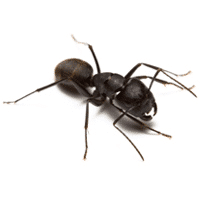Carpenter Ants
The worker ants range in length from 1/8 – 1/2 inch, with the queens being slightly larger. They are most commonly black, although some species are red, red and black, or brown.
Modern’s Carpenter Ant Control Service includes a thorough inspection and detailed report on where ant infestation has occurred.
What is a Carpenter Ant's Diet?
Carpenter ants do not actually feed on the wood. They feed actively from sunset until the early morning hours on most human foods, particularly sweets and other insects.
What is a Carpenter Ant's Reproductive Cycle?
Soon after mating, swarmers lose their wings. The female selects a nesting site to lay her eggs and begins the process of hollowing out tunnels and galleries to lay her eggs. Mature colonies can range in size from 10 to upwards of 15,000.
Where Do Carpenter Ants Live?
These ants are social insects that prefer nesting in wood. They commonly hollow out galleries or tunnels in trees, structures, wood, and foam insulation.
Carpenter ants are often found in conjunction with moisture problems. An indication of a possible infestation is evidence of sawdust, pieces of insulation, nesting materials, and winged adults, known as swarmers.
Carpenter ants have main colonies and sub (satellite) colonies. The main colony takes about five years to mature and is most often found in the woods. Once mature, the large colony needs help so it sends out swarmers that locate spots in the vicinity where the sub-colonies can thrive. Once a spot is found, they rip off their wings and start setting up shop. Each sub-colony has a job (such as caring for all the eggs or collecting water) but they all depend on the main colony and frequently travel back to the main colony at night to help out.
Once mature, the main colony will continually be setting up sub-colonies. Homes are ideal for them since there are reliable water sources there – we often find the colonies around window or door frames or in the kitchen or bathroom.
Why are Carpenter Ants a Pest?
Carpenter ants are more than a nuisance pest because they prefer to nest in moist and/or rotting wood, making your home an ideal location to set up shop.
For instance, a leaky or sweating pipe may be creating moisture in wall voids, which is undetectable to you and perfect conditions for carpenter ants. They will excavate the moist or rotten wood to create a new sub-colony, therefore compromising the integrity of the structure.
What Is The Modern Solution?
In protecting your home against carpenter ants, Modern takes into account the biology of this pest and that is why we try to get people on a seasonal visit program. This allows us to get to your home before the wood destroying ants do each year. Our seasonal visit program guarantees you protection from these continual, wood-destroying invaders throughout the spring and summer.
Homeowners insurance rarely covers the cost of carpenter ant damage. Therefore, prevention and protection against carpenter ants is a worthwhile investment to protect your home and business.
Ready to Schedule a Service?

